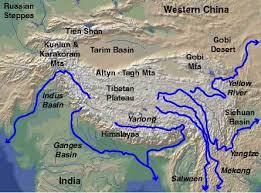
Is Water a New Flashpoint for Asia’s Rising Giants?
In the past, India and China have disputed numerous issues, from trade to territory. Notably, in 1962, disputes over their Himalayan border regions sparked the brief Sino-Indian War. In the 21st century, a new issue has the potential to become a flashpoint between the world’s most populous nations: their shared rivers.
China has planned, and in some cases begun construction on, major hydropower and water diversion projects in its southern regions, including Tibet, which is making the water security of its downstream neighbors more fragile. The glacial Tibetan Plateau, largely controlled by China, is the source of rivers that supply water to approximately 1.5 billion people. Many of Asia’s major rivers—including the Mekong, Brahmaputra, Yangtze, Yellow, Indus, and Salween Rivers—begin in the Tibetan Plateau, and supply water to people living in India, Pakistan, Bangladesh, Afghanistan, Nepal, and mainland Southeast Asia. Thus, China exerts powerful hegemony over Asia’s water resources.
China views the development of rivers originating within its borders as a matter of national sovereignty, not international cooperation. According to one telling Chinese proverb, “Upstream doesn’t suffer.” China does not have river treaties with other nations, making downstream countries vulnerable to water supply disruptions and other environmental damages. In the absence of treaties, downstream nations have no forums for formally resolving water disputes with China, and cannot use international legal institutions to ensure they receive their fair share of water.

Trading Water: Could Markets Be One Solution to California’s Water Woes?
Drought-stricken California is taking unprecedented measures to address its water challenges.
In April, the governor issued the first mandatory statewide water use restrictions in California history, after snowpack in the Sierra Nevada Mountains—which provide 60 percent of the state’s water—fell to the lowest levels ever recorded. San Diego County is building the largest seawater desalination plant in the Western hemisphere, while Orange County plans to turn more wastewater into drinking water.
The solutions are significant because the drought has been exceptionally severe. It currently affects over 99 percent of the state and approximately 37 million people. In 2014, the state agriculture industry lost roughly $2.2 billion to drought, and some California communities even ran out of water.
One solution California may consider is whether more efficient, user-friendly water markets would help water users adapt more quickly to drought conditions, and better cope with long-term water scarcity stemming from climate change and increased water demand.
California has active water markets, but buying and selling water (and water rights) there is not as simple as in Australia, where it is said to be “almost as easy to sell water from your water bank account as it is to transfer money from a normal bank account.” The Australian model could be useful for California because Australia recently emerged from a decade-long drought, during which it pioneered water policies that attracted interest from water-scarce countries around the world.
Why is water trading easier in Australia? One reason is that Australia’s water rights system has been made relatively simple and predictable. It is designed so that rights holders can generally expect to receive a certain percentage of their water every year, based on the type of water right they hold. This makes water rights’ value easier to determine; the water rights transfer process is also less onerous.










